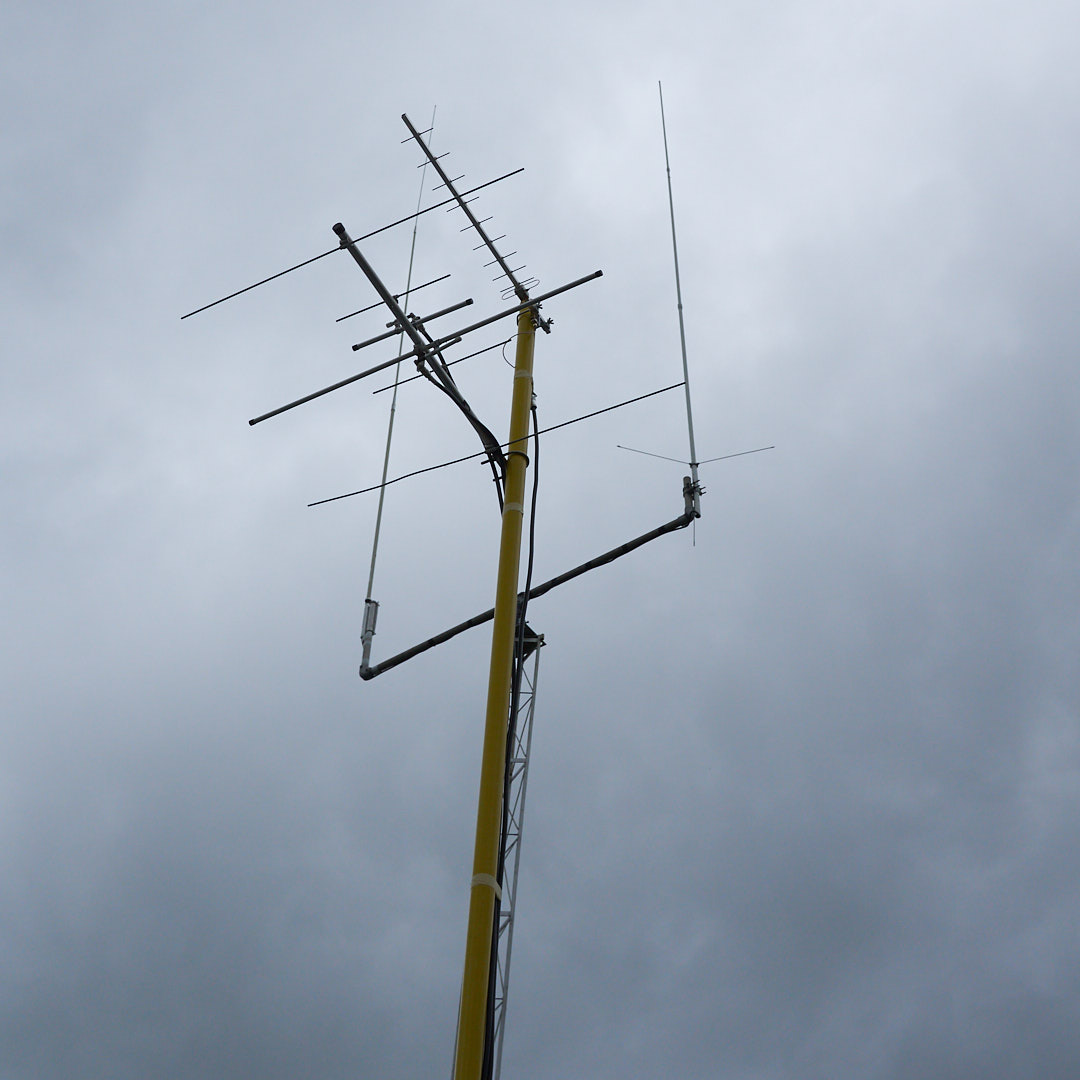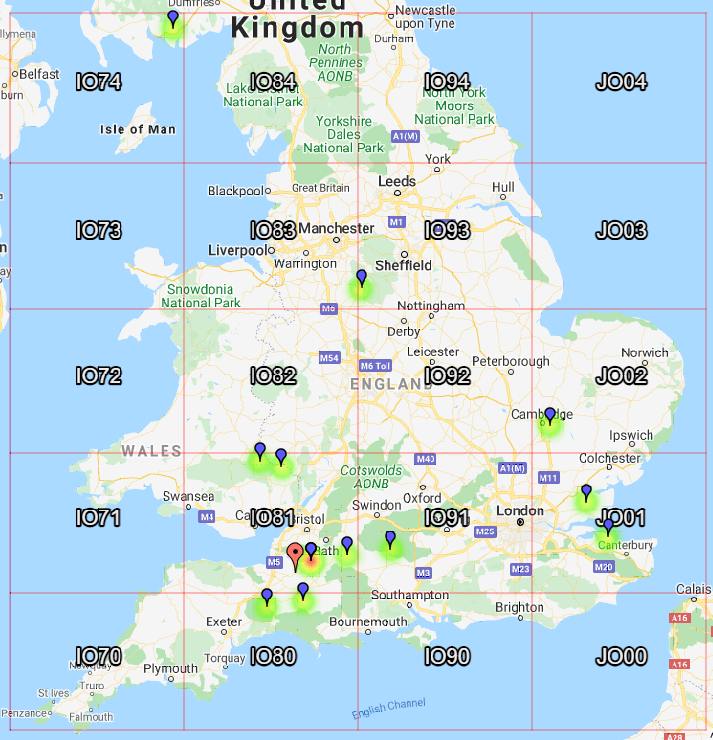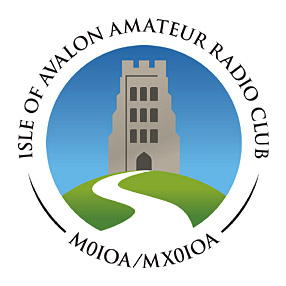VHF/UHF Field day
We took the opportunity to try out Site 2 for VHF/UHF field day. We are never going to set the bands alight from a site at sea level, but it has a good clear view of the horizon, and lets us test out how well we can operate using batteries and a generator to float charge them. It went well, in that Matt’s Icom rig was able to transmit at 100W and the generator and batteries maintained decent levels.
Many thanks to Simon from Shepton Mallet who came along and also lent us his 23cm Yagi, which gave us a 23cm contact with G2BQY/P up near Maesbury Castle in IO81rf
We rigged the antennas for the experiment

The yellow fibreglass pole is some distance in front of the tower. We don’t have a rotator for the tower, which is why we use the lower fibreglass with an Armstrong rotator.
I mapped the contacts using the RSGB VHFCC’s contest mapper.

We have entered our results in the RSGB VHFCC log as a fixed sweeper restricted
| Section | Callsign | Loc | QSOs | QSO Points | P/Qso | Best DX | Dist | Power | Ant |
|---|---|---|---|---|---|---|---|---|---|
| FSR | MX0IOA | IO81 | 14 | 1,784 | 127 | GM3HAM/P | 428 | 100 | Cushcraft 3 el Yagi |
what we learned from the exercise
You wouldn’t start to do a VHF operation from sea level if you’re pitching for the leader board, but we reached Scotland and the east coast, so the site has a decent take-off. The Scotland result is surprising because I would have expected the Mendip Hills to the north to limit things severely, but that did not seem to be the case. We are not at the bottom of the scoreboard ;)
You have to switch the generator on if you are going to run 100W. There is a case to be made that we need to improve our 12V cabling, but even with two deep-cycle batteries in parallel it seems to need the generator for TX on full power. The station that queried our audio signal quality gave us the OK later on, so clearly the generator does prevent the voltage level becoming marginal. Different rigs behave differently with respect to low supply voltage. We were measuring about 12.6V at the batteries on TX without the generator.
The FT450 for instance used to trip out at >40W, but can sustain full power with the generator. We need to investigate the performance of the batteries under load, examining at the rig end and at the battery end. Initially I had assumed the FT450 tripping indicated we need to beef up the cable size to reduce voltage drop, but if bridging the generator across the batteries eliminates the problem it would appear that the voltage drop under load may be at the battery end.
The first day we logged with paper, the second day we commissioned a copy of Minos which is the RSGB recommended logging program for VHF contests. We could immediately see the value it brings to the party.
The generator did not seem to add significant QRM to the background. Either on VHF or later on we tried it with the FT450D on HF. It is fairly low-tech and ancient 12V unit, but the ignition noise did not seem perceptible on HF or VHF. This is good news.
Matt’s IC-7900 worked well and the panadapter display was a great help. I missed this when trying out NFD on my old-skool FT897. However, I was trialling Minos in the morning, and that helps users of older rigs by showing a bandmap feature, which captures the stations you have worked. This tracks the frequency selected on the radio. It’s obviously not as good as having a panadapter display, but for little pistol stations running search and pounce knowing where the big guns are and if you have worked them before as you tune through is a big help. Having a panadapter and Minos as we did in the afternoon is of course the best.
You can’t select the Icom 7900 with Minos, but you can set it up as a Icom 7300. You really do not want RTS force asserted when setting the rig up, as it will go into TX right away. The FT897 was a doddle to set up in comparison, but we got there in the end.
log
The contest started on 14:00 so the first two contacts were practice runs.
| Time | Call | Band | Sent RS | S Serial | Rcvd RS | R Serial | Locator | |
|---|---|---|---|---|---|---|---|---|
| 13:47 | G0GRI/P | 2m | 59 | 57 | IO81rf | |||
| 13:55 | GW3UZS | 2m | 57 | 57 | IO81jm | |||
| 14:02 | G0GRI/P | 2m | 59 | 001 | 57 | ? | IO80qw | IO81rf |
| 14:08 | G4WAW/P | 2m | 59 | 002 | 59 | 004 | IO81rf | |
| 14:19 | G3CKR/P | 2m | 59 | 004 | 57 | 023 | IO93ad | |
| 14:27 | G0ARC/P | 2m | 59 | 005 | 55 | 025 | IO91eh | |
| 14:29 | G2BQY/P | 23cm | 59 | 001 | 59 | 004 | IO81rf | |
| 14:40 | M0BAA/P | 2m | 58 | 006 | 59 | 046 | JO01kj | |
| 14:51 | G0LTG/P | 2m | 59 | 007 | 59 | 010 | IO81rf | |
| 15:04 | G4JBH | 2m | 57 | 008 | 59 | 012 | IO80qw | |
| Sun 4 | ||||||||
| 12:20 | G0BKU/P | 2m | 57 | 009 | 57 | 012 | IO81wg | |
| 12:32 | M0BAO/P | 2m | 59 | 010 | 59 | 030 | IO80lv | poor audio report to us |
| 12:38 | GW1BBY/P | 2m | 59 | 011 | 59 | 088 | IO81kw | |
| 13:03 | GM3HAM/P | 2m | 52 | 012 | 57 | 117 | IO74wv | |
| 13:10 | GW4IDF/P | 2m | 58 | 013 | 59 | 050 | IO81nv | |
| 13:51 | G3PYE | 2m | 59 | 014 | 59 | 248 | JO02ce | |
| 13:54 | G8BGV/P | 2m | 52 | 015 | 52 | 051 | JO01hp |
